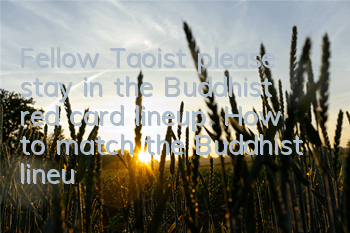Fellow Taoist, please stay at the Buddhist lineup guide. Finally, how to form and match the Buddhist orange card and red card lineups. Below, the editor will bring you a guide to the Buddhist lineup guide for the Buddhist lineup of Taoist, please stay at the mobile game, hoping to help everyone.
Fellow Taoist please stay at the human, Buddha, Taoist, and demon
Introduction to Buddhist lineup
The same is true for the demon players. Many players who play Buddha are not sure about the strength of their lineup. However, what is better about Buddhism than other races is that the characters are familiar with them! Sun Wukong, Zhu Bajie, Tang Seng, Guanyin, etc. are all familiar characters. The characters of Buddhist real people are basically based on Journey to the West, which is more down-to-earth than comparison. Moreover, the five-player group in Journey to the West is not weak. At the beginning, I also played for the five-player group in Journey to the West. I didn’t know much about other gods. After playing for a while, I would feel that it would be more reasonable to write about Buddhist things. OK, let’s not say much nonsense, let’s see.
Fellow Taoist Taoist please stay at Samantabhadra Bodhisattva
Buddhist lineup Red Card Tang Monk
Let’s talk about Tang Monk first, why did you take out the red card to talk about it this time? Because Tang Seng is a red card, it is very cost-effective and plays an important part in the Buddhist lineup, but as the main general training feels a bit insufficient. The reason for saying this is that Tang Seng's skill increases the damage to the enemy in the next two rounds by 30%, and increases the 2 random friendly parties by 2 points of anger. Assuming that in one situation, Tang Seng takes action to add the damage increase effect to the opponent, and then adds anger to himself, and then the combined skills can be released in the third round, so this damage is enough. However, Tang Seng takes action as the number one position, and no one in the lineup lacks anger, and it is not added to Tang Seng, so it is more embarrassing. The output of the lineup in three rounds is much worse.
But it is undeniable that as a red card, Tang Monk should play a role in the Buddhist lineup. In the Orange Card era, Tang Monk can stably transition to the Red Card era, and then give Dapeng Ming King stable damage increase support in the Double Red Card era. Dapeng Ming King has a relatively high initial damage, and has an angry reduction skill, and a 25% chance of stun. This is the kingly way. At the same time, Tang Monk can also provide stable halo support to Dapeng Ming King. After advanced +7, Tang Monk attack can provide friendly troops with 20% attack bonus, 7% damage bonus, and 10,000 health bonus. It is very important for Buddhism, because what is special about Buddhism is that it lacks a halo of damage bonus. When the damage is played by red cards in the later stage, Tang Monk's halo can be slightly compensated.
So the way out of Buddhism is the same as the demon clan, and it can only rise in the era of double red cards. It is recommended to combine the double red cards of Dapeng Mingwang + Tang Monk + Ksitigarbha Bodhisattva + Peacock Mingwang. The remaining one can choose an orange halo. If you are a rich man, you can go to Guanyin. In fact, Tang Seng himself is not weak. In the late stage, because of the advanced talent of +1 of anger after +8, he can ensure that the skills are released as soon as possible. If the face is good, the anger of the skill can be added to himself.It is also basically a big move, and the opponent can't stand it in a minute when he cooperates with the damage-increasing buff he hits. But overall, I think the positioning of Tang Seng should be the second leader of Buddhism, and the output still needs to be counted on Dapeng Mingwang to fight.
Tang Monk's contribution is not only to himself, including his joint attack deputy, Ksitigarbha Bodhisattva. The milk volume in the early stage is not obvious, but after the coefficients such as attack and damage bonus in the later stage are definitely the king of battery life. He can enjoy continuous blood increase in two rounds after one blood increase. The amount is very objective, but his advantages are indeed not reflected in the early stage.
Buddhist lineup Orange Card Little White Dragon
In the middle, there is also a link to who will the Buddhist orange card halo be used, Samantabhadra or Little White Dragon? Personally, I tend to be Xiaobailong. Because when Samantabhadra does not have a joint attack, the skill can only return two points of anger at one time, which is not stable. When the skill cannot be released, such as being reduced or being beaten down, there is no way to stabilize support. Xiaobailong can provide Rage +1 support stably even if he is not on the court in each round. Buddhism and the demon clan have relatively similarities. They are stronger in the later stage and are very powerful in the protracted war. However, the difference is that the demon clan constantly weakens the other party, while Buddhism constantly increases its own strength and constantly attacks its opponents by increasing injuries and anger.
Recommendation of Buddhist lineup combination
After talking about Tang Seng, let’s talk about the Buddhist orange card combination. The most direct one should be the Journey to the West combination, Sun Wukong + Zixia + Zhu Bajie + Sha Seng + Ksitigarbha Bodhisattva + protagonist combination. This group has a very high output. Wukong’s single-second skill, Bajie’s vertical damage, and may also get four points of anger. But the embarrassing thing is that if both of them are in the front row, they cannot hit the same person, and it may cause a blow to not destroy the opponent’s main force after a blow. This is more embarrassing, because this combination does not have a hard control (reduce anger, dizziness, etc.), which may cause a turnaround. However, the advantage of Wukong’s number one position is that it can ensure that the opponent is disabled. In the early stage of getting Tang Seng, you can consider Tang Seng’s number one position and Monkey Brother’s number two position, and directly kill the opponent’s number two position in seconds, and achieve the goal of gaining advantage by killing the opponent’s lineup structure. The advantage of this lineup is that it has a high output, which is relatively stable, and the pressure to pass the picture is less.
But I prefer pk, and I use the role of civilian players when playing Buddha, so I prefer Samantabhadra + Manjushri + Bajie + Sha Seng + Ksitigarbha. This group is very gambled. Bajie's own anger is unstable, but with Samantabhadra's anger, the overall probability can be increased to about 66%. In this way, the output is easier to be produced, because Bajie's own output is not weak and worth cultivating.
In summary, Buddhism recommends using Tang Monk's transition in the era of red cards, and then transfers to the double red cards of Dapeng Mingwang. Those with resources can raise Guanyin, and those with insufficient resources can consider raising a little white dragon. This can maximize the characteristics of Buddhism, add anger + protracted war. Basically, this combination has advantages in both the picture and the pk.
A player asked before why the recommended red cards were used to assist. Let me explain it here, because considering that it is more stressful to raise a red card at the beginning, you can consider spending some time to accumulate the second red card. If you give it to assist at the beginning, you can first gather the fate to maximize the combat effectiveness of the current lineup, instead of rushing to the red card at the beginning. This is a long-term game, and you don’t rush for a moment.
Fellow fellow Taoists please stay at the promotional map
Orange Card Lineup Recommendation
1. Wukong Group + Bajie Group
Advantages: Super explosive ability, Bajie has the ability to continuously output, Zixia has group control. The entire lineup is more balanced. The only drawback is the lack of range damage and the impact on the back row is relatively limited.
Formation: Wukong, Bajie, the protagonist, Zixia, Sha Seng, Di Ksitigarbha
Aided: Tang Monk, Little White Dragon, Manjushri, Peacock King, Qingxia Fairy, Tiger and Arhat
2. Bajie Group + Samantabhadra Group
Advantages: The Samantabhadra group belongs to an underrated group. It causes certain damage to the front row enemies and increases anger to the gods on one side. Manjushri will also impose negative states on the gods on the other side. In fact, from another perspective, it is to maximize the use of Bajie's characteristics and strengthen Bajie's ability to continuously output. Combined with the Samantabhadra group's Huinu and Bajie's own skill Huinu, Bajie may be able to use his ultimate move, which will be devastating to the opponent's attack. The disadvantage is that the rebirth is unstable, and it is not guaranteed that Bajie will always be angry, so the output of the lineup is very unstable, which depends too much on the face.
Formation: Bajie, Samantabhadra, the protagonist, Manjushri, Shaseng, and Ksitigarbha
Aid: Tang Monk, Little White Dragon, Tiger Subduing Arhat, Ananda, Kashyapa, Dragon Subduing Arhat
Red Card Lineup Recommendation
1. Double Red Card Lineup
Tang Monk Group + Dapeng Mingwang Group, Halo will choose Xiaobailong
Advantages: Tang Monk's output will also exert negative effects on the opponent, and Dapeng Mingwang has a strong control effect while hitting the front row of the local area, so it is recommended that Dapeng be placed in one number. After all, the opponent's back row will not take action before Tang Monk. Combined with Tang Monk's rage and the excitement aura of little white dragon, the output speed of Buddhism can be guaranteed, and then rely on Dapeng + Tang Monk's continuous control + damage to defeat the opponent. At the same time, as an auxiliary general with an exciting aura, the other auras also have good effects, and their skills are also an angry and veritable angry general.
Design: Dapeng Ming Wang, Tang Monk, Little White Dragon, Peacock Ming Wang, The protagonist, Ksitigarbha Bodhisattva
Aided: Guanyin, Sun Wukong, Zhu Bajie, Sha Seng, Manjushri, Zixia
2. Three red card lineup
Tang Monk Group + Dapeng Ming Wang Group, partner with Guanyin Bodhisattva
Advantages: Guanyin Bodhisattva is considered an enhanced version of the little white dragon. The ordinary attack has the chance to increase his anger and can release his anger skills faster. Moreover, Guanyin's advanced aura is better than the little white dragon.More. After adding hit attributes, Guanyin's angrily skill has a higher success rate than the little white dragon. Cooperating with the mechanisms of Tang Monk and Dapeng, Buddhism is the type that becomes braver the more you fight.
Formation: King of Great Peng Ming, Monk of Tang, Guanyin, King of Peacock Ming, protagonist, Ksitigarbha Bodhisattva
Aided: Sun Wukong, Xiao Bailong, Zhu Bajie, Sha Seng, Manjushri, Samantabhadra
3. Three red card lineup
Tang Monk Group + Dapeng Mingwang Group, Halo will choose Xiaobailong
Formation: Tang Monk + Ksitigarbha Bodhisattva + Zhu Bajie + Sha Monk + Little White Dragon
Aid: King of Peng Ming, Monkey King, Manjushri Bodhisattva, King of Peacock, Samantabhadra Bodhisattva, and Fairy Zixia
4. Three Red Card Lineup
Tang Monk Group + Dapeng Mingwang Group, Halo will choose Xiaobailong
Formation: Tang Monk + Sun Wukong + Zixia Fairy + Ksitigarbha Bodhisattva + Little White Dragon
Aid: Dapeng Ming Wang, Zhu Bajie, Sha Seng, Manjushri Bodhisattva, Samantabhadra Bodhisattva, Peacock Ming Wang
5. Three red card lineup
Tang Monk Group + Dapeng Mingwang Group, Halo will choose the little white dragonAid: Dapeng Mingwang, Sun Wukong, Zhu Bajie, Sha Monk, Peacock Mingwang, Dragon Subduing Arhat
The Buddhist orange card is more popular and has a higher bonus, so it seems that there will be about one less destiny than other tribes, but the actual effect is higher.
6. Three red card lineup
Tang Monk Group + Dapeng Mingwang Group, Halo will choose Xiaobailong
Formation: Tang Monk + Ksitigarbha Bodhisattva + Peacock King + Great Pluto King + Little White Dragon
Aid: Sun Wukong, Zhu Bajie, Sha Seng, Manjushri Bodhisattva, Guanyin Bodhisattva, Zixia Fairy
The above is the last four articles brought to you by the editor of 87G. Please stay at the Buddhist lineup guide. I hope that these guides can help you choose the direction of lineup matching. If you want to know other lineup content, please pay attention to the 87G mobile game guide area.









